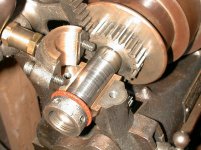This is my first post and interested in learning machining.
I am finial getting hands on machining after picking up this Seneca Falls Star Lathe. Been googling the manufacture but not much info for it beside sales catalog vs competitor manufacturers like south bend and etc. it
What I know of the lathe I have is
model: QCE
Advertise as a 11” but has an actual 12” swing
QC GB
Has taper attachment
MT2 tailstock taper
Can’t feel any play in the head stock by hand and the ways looks good to me
Plenty of different style of HSS tooling
The precious owner made a nice motor mount and cover for it attached to the lathe vs hanging it off the wall or table top
Don’t know the year it’s made and will probably never know from the research I found. It does have all the latest and greatest patent so it’s probably in the 1930’s I would say.
When I loaded it up to the truck the lathe was tilted to load one end at a time on its legs. Some oil spilled out. I started turning and oil every hole I found to try and replace the spilled oil. But the main head stock bearing oil seems odd. Once I added a couple of oil pumps into the hole, using only 10w30 for now, oil found its way out of the headstock squeezing though the bearing towards the chuck. Does that sounds right? I Don’t know where the oil reserves for the head stock is to lube the bearings as it spins to check level. That’s my main concerns now. Didn’t want to fry the lathe already due to oiling.
I would like to post pictures but not sure how this forums handles it
Thanks for any help you can provide
I am also on a quest to find a draw bar and collet set for it and a 4 jaw chuck
I am finial getting hands on machining after picking up this Seneca Falls Star Lathe. Been googling the manufacture but not much info for it beside sales catalog vs competitor manufacturers like south bend and etc. it
What I know of the lathe I have is
model: QCE
Advertise as a 11” but has an actual 12” swing
QC GB
Has taper attachment
MT2 tailstock taper
Can’t feel any play in the head stock by hand and the ways looks good to me
Plenty of different style of HSS tooling
The precious owner made a nice motor mount and cover for it attached to the lathe vs hanging it off the wall or table top
Don’t know the year it’s made and will probably never know from the research I found. It does have all the latest and greatest patent so it’s probably in the 1930’s I would say.
When I loaded it up to the truck the lathe was tilted to load one end at a time on its legs. Some oil spilled out. I started turning and oil every hole I found to try and replace the spilled oil. But the main head stock bearing oil seems odd. Once I added a couple of oil pumps into the hole, using only 10w30 for now, oil found its way out of the headstock squeezing though the bearing towards the chuck. Does that sounds right? I Don’t know where the oil reserves for the head stock is to lube the bearings as it spins to check level. That’s my main concerns now. Didn’t want to fry the lathe already due to oiling.
I would like to post pictures but not sure how this forums handles it
Thanks for any help you can provide
I am also on a quest to find a draw bar and collet set for it and a 4 jaw chuck













